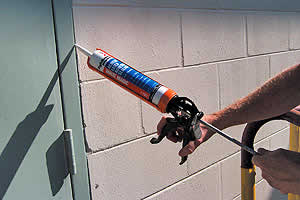
Exterior Caulking
How do you choose from the bewildering array of caulk types out there? Start by understanding their characteristics.
by John Strieder
Todd Olson says he hasn’t had an exterior caulk job go bad in a decade. But achieving that seemingly simple goal takes work. “I do my homework first,” he says. “I don’t want to set myself up for failure.”
All he wants from an exterior sealant is something that won’t turn into a disaster. “I just want to know if it works, who’s going to stand behind it and how long it’s going to stay here.”
 He has a lot of caulks to choose from — and a lot of bad decisions to avoid. He has a lot of caulks to choose from — and a lot of bad decisions to avoid.
There are external caulks made from silicones, polyurethanes, acrylic latex, butyl rubber, synthetic rubbers, and many combinations thereof. Each has its pros and cons. “In sealers, everything is a tradeoff,” says Scott Burkitt, national sales manager for GE Sealers & Adhesives, manufacturers of Lighthouse products.
Acrylic latex caulks, for example, are the most popular. They adapt well to drying green wood on a job site and adhere to many different substrates. They are paintable, low in toxins, easier to “gun” than polyurethanes or rubbers, and can be cleaned up with water. “No manufacturer has been able to come out with a product that has all the things painters like about acrylic latex,” Burkitt says.
But acrylic latex sealants have flaws, too. The water-based caulks cure as their water evaporates. This means they shrink, Burkitt says, and if they are painted over, the paint may crack.
“In residential and multi-family housing, latex sealants are predominately used,” says Eddie Hess, in new business development at Gardner-Gibson. “But you will still see a lot of silicone rubber and polyurethane sealants used in commercial construction.”
Silicones and urethanes are known for durability and movement capability, says Bruce Kermode, senior project manager in the caulks and sealants division of Sherwin-Williams. The longest-lasting sealants are silicones, urethanes and urethane hybrids, he says.
Silicone and polyurethane sealants last the longest, Hess agrees, but are also the most expensive and difficult to work with. “They don’t tool very well, are hard to clean up and in the case of [traditional] silicone, not paintable.”
Polyurethane caulks are preferred for masonry and cement because they adhere well to porous substrates, Burkitt says. But what urethanes gain in adhesion they lose in durability, he says, and urethanes are outperformed by silicones and acrylics in warmer climates such as Texas, Florida and Southern California. “In high heat, polyurethane just doesn’t hold up as well.”
Adherence. Silicones and urethanes adhere best to metal, says Stephen Sicree, senior chemist with OSI Sealants Inc. And urethane, latex and synthetic rubber-based caulks are all better on wood than unpaintable silicones, he says. “If wood is painted, silicones are kind of out.”
Silicones work best with glass and ceramic, Kermode says.
Finally, there are butyls, which are not used much by contractors in exterior caulking these days. But they still turn up. They often provide the primary seal in insulated glass windows, Sicree says, as their low water-vapor transmission rate stops moisture from seeping between the two panes of window glass. A secondary seal of silicone provides the strength butyl lacks, he says.
Unlike most other caulks, silicone is based on sand, not oil. And that makes a difference in how silicone caulks perform.
“Silicones are considered the gold standard for flexibility,” Sicree says. “They can’t change properties with time. They have excellent memory.”
Because silicones are more flexible, durable and adherent than many of their peers, they are preferred for caulking joints, Burkitt says. “The big difference between silicones and all others is durability. It won’t break down.”
Of course, silicones also have negatives. They are thicker than other caulks, so they’re harder to gun. They can’t be cleaned up with soap and water. Perhaps worst of all for contractors, traditional silicones can’t be painted.
A new concept in hybrid caulks, dubbed the “paintable silicone,” is designed to change that. Made of silicones combined with more paintable materials, they are touted as offering all the benefits of traditional silicone plus the paint-friendliness of their peers.
But so far, paintable silicones have proven to be far from perfect. One paintable silicone caulk only takes paint between two and 48 hours after application, Burkitt notes.
Burkitt’s company recently introduced paintable silicones that can be painted anytime after the sealant skins over. But the product is still thicker than acrylic latex, he admits, and paintable silicones cost roughly twice as much as acrylic latexes.
Hess also votes thumbs down. Paintable silicones require multiple coats of paint to hide the caulk bead, he says, and while he knows of another “silicone technology” product that works well, it is also very expensive. “You won’t see many contractors using $7 caulk on any job.” |

